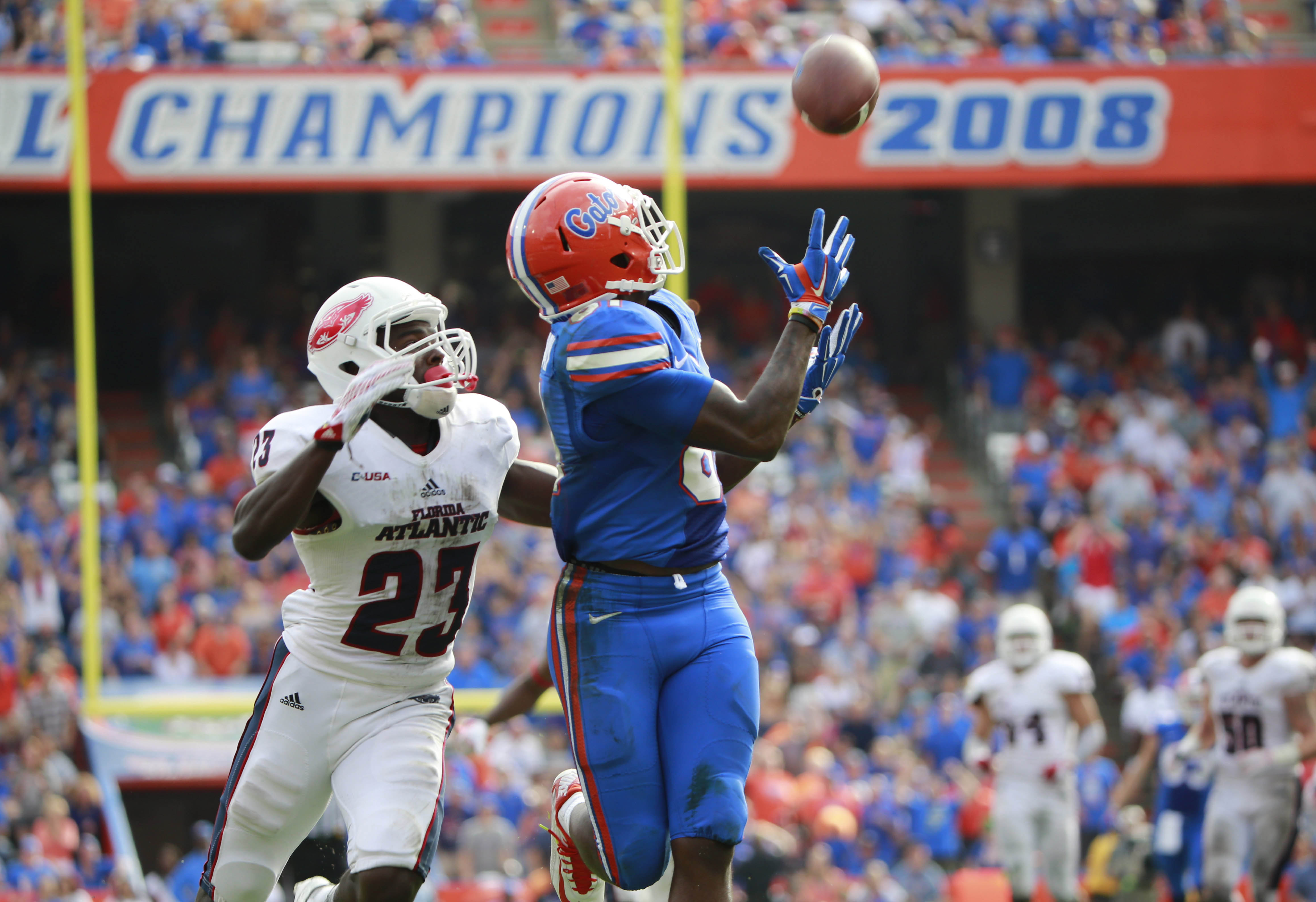
Is 2017 the year Florida finally produces another 1,000-yard receiver?
By Andrew Olson
Published:
GAINESVILLE, Fla. – For a team whose identity is so closely tied to passing the football, it’s been a surprisingly long time since the Gators have been able to claim a 1,000-yard pass-catcher.
It doesn’t seem like a lot to hit 1,000 yards over the course of a season, but the number has eluded many Gators wide receivers who have gone onto play in the NFL (Chad Jackson, Andre Caldwell, Percy Harvin, Riley Cooper, Lewis Murphy). The last Florida wide receiver to hit the four-digit mark in a season was Taylor Jacobs, who had 1,088 receiving yards in 2002. It was technically the first year of the Ron Zook era, but with Rex Grossman throwing to Jacobs, it felt like the Fun ‘N’ Gun at times.
Since then, a lot of great wideouts have passed through Gainesville, but none can claim a 1,000-yard season. Will the 2017 be the year that the drought ends? A look at the roster, who’s come close and a recent history of Jim McElwain-coached receivers should give us some idea.
2017 contenders
Florida’s obvious 1,000-yard candidates are junior Antonio Callaway, a proven go-to wideout, and sophomore Tyrie Cleveland, a highly touted 2016 recruit primed for a breakout sophomore season. Callaway, a 3-star signee in 2015, has been the Gators’ top pass-catcher the past two seasons (678 yards in 2015, 721 yards in 2016) in an offense severely hampered by quarterback play. Cleveland, a 4-star recruit and No. 2 wideout of his class, got off to a slow start as a freshman, but made strides in the second half of the season.
Cleveland is the taller of the two (6-2 to 5-11), which could factor into the quarterback’s preference. When it comes to speed, the two appear to be comparable. Florida’s quarterback – whether it’s Feleipe Franks, Kyle Trask or Luke Del Rio – could potentially develop chemistry with one of Callaway or Cleveland as the go-to receiver, with the other posing enough of a threat to keep defenses honest. McElwain called Callaway a “security blanket” for the quarterbacks at Tuesday’s spring practice.
How about both?
If the Gators produce two 1,000-yard wideouts in 2017, it might be a sign that Steve Spurrier is doing more at Florida than his “ambassador and consultant” title suggests. The last time a Florida team had multiple 1,000-yard receivers was in 2001. Jabar Gaffney led the team with 1,191 receiving yards while Reche Caldwell added 1,059. Taylor Jacobs’ 712 yards and 7 touchdowns put him at No. 3 on the 2001 team, but that would have been team-leading numbers frequently in the past decade.
Last year, there were only two 1,000-yard wide receivers – Josh Reynolds (Texas A&M, 1,039 yards) and J’Mon Moore (Missouri, 1,012 yards) – in the entire conference. The last SEC team to have multiple 1,000-yard receivers was LSU, when Odell Beckham and Jarvis Landry did it in 2013.
Florida receivers since 2002
In the 14 seasons that followed Jacobs’ 1,000-yard effort in 2002, four head coaches have roamed the sidelines in Gainesville, which means the Gators have had a variety of approaches on offense. Zook lasted two more seasons, but his teams did not produce another 1,000-yard receiver.
Urban Meyer followed Zook from 2005-10. Meyer’s offenses are best remembered for Tim Tebow running the spread, but they came close to producing 1,000-yard receivers. In 2005, Chad Jackson wracked up 900 receiving yards. The next year, Dallas Baker topped that with 920 yards. The closest went to Riley Cooper, who logged 961 receiving yards in 2009.
In the Will Muschamp era (2011-14), only one wideout, Demarcus Robinson, could be considered in the ballpark of the 1,000-yard mark. Robinson posted 850 receiving yards in 2014 as a sophomore.
McElwain’s recent history with 1,000-yard receivers
McElwain knows what’s it like to coach a 1,000-yard receiver as an SEC offensive coordinator and as a head coach. At Alabama, McElwain had the luxury of calling plays to get the ball in the hands of Julio Jones for three seasons (2008-10). Jones was almost a 1,000-yard receiver as a freshman (924 yards). The number dropped significantly to 596 yards in 2009 (the only national championship team in Jones’ three years, for what it’s worth). In his final season, Jones had 1,133 yards.
In 2014, McElwain’s third year as head coach at Colorado State, Rashard Higgins set a single-season school record with a whopping 1,750 receiving yards. This was the same season Garrett Grayson set the single-season record with 4,006 passing yards. For Gators fans, this should be a reminder that McElwain is comfortable with airing it out when he has the right personnel.
The Gators are talking about letting it fly this spring.
But McElwain’s offense seems unlikely to produce another Gaffney-Caldwell duo. When a wideout hits 1,000 yards under McElwain, there has been a sizable gap in production between the Nos. 1 and 2 receivers. When Jones had his 1,000-yard season in 2010, Marquis Maze was Alabama’s No. 2 wide receiver with 557 yards. Similarly, when Higgins set the record at CSU, the Rams’ No. 2 wideout that year, Joe Hansley, had 540 receiving yards.
Andrew writes about sports to fund his love of live music and collection of concert posters. He strongly endorses the Hall of Fame campaigns of Fred Taylor and Andruw Jones.







